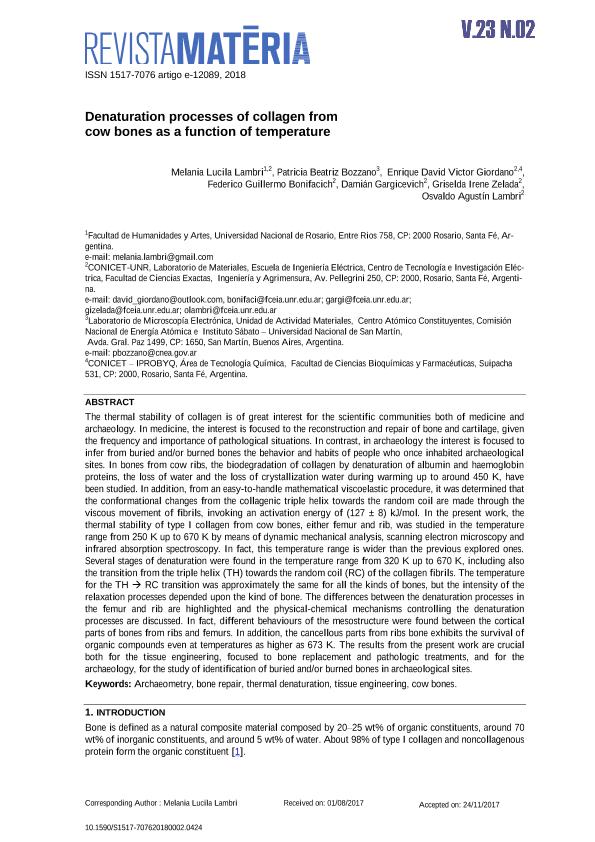Artículo
Denaturation processes of collagen from cow bones as a function of temperature
Lambri, Melania Lucila ; Bozzano, Patricia Beatriz; Giordano, Enrique David Victor
; Bozzano, Patricia Beatriz; Giordano, Enrique David Victor ; Bonifacich, Federico Guillermo
; Bonifacich, Federico Guillermo ; Gargicevich, Damian
; Gargicevich, Damian ; Zelada, Griselda Irene; Lambri, Osvaldo Agustin F.
; Zelada, Griselda Irene; Lambri, Osvaldo Agustin F.
 ; Bozzano, Patricia Beatriz; Giordano, Enrique David Victor
; Bozzano, Patricia Beatriz; Giordano, Enrique David Victor ; Bonifacich, Federico Guillermo
; Bonifacich, Federico Guillermo ; Gargicevich, Damian
; Gargicevich, Damian ; Zelada, Griselda Irene; Lambri, Osvaldo Agustin F.
; Zelada, Griselda Irene; Lambri, Osvaldo Agustin F.
Fecha de publicación:
07/2018
Editorial:
Universidade Federal do Rio de Janeiro
Revista:
Matéria
ISSN:
1517-7076
Idioma:
Inglés
Tipo de recurso:
Artículo publicado
Clasificación temática:
Resumen
The thermal stability of collagen is of great interest for the scientific communities both of medicine and archaeology. In medicine, the interest is focused to the reconstruction and repair of bone and cartilage, given the frequency and importance of pathological situations. In contrast, in archaeology the interest is focused to infer from buried and/or burned bones the behavior and habits of people who once inhabited archaeological sites. In bones from cow ribs, the biodegradation of collagen by denaturation of albumin and haemoglobin proteins, the loss of water and the loss of crystallization water during warming up to around 450 K, have been studied. In addition, from an easy-to-handle mathematical viscoelastic procedure, it was determined that the conformational changes from the collagenic triple helix towards the random coil are made through the viscous movement of fibrils, invoking an activation energy of (127 ± 8) kJ/mol. In the present work, the thermal stability of type I collagen from cow bones, either femur and rib, was studied in the temperature range from 250 K up to 670 K by means of dynamic mechanical analysis, scanning electron microscopy and infrared absorption spectroscopy. In fact, this temperature range is wider than the previous explored ones. Several stages of denaturation were found in the temperature range from 320 K up to 670 K, including also the transition from the triple helix (TH) towards the random coil (RC) of the collagen fibrils. The temperature for the TH → RC transition was approximately the same for all the kinds of bones, but the intensity of the relaxation processes depended upon the kind of bone. The differences between the denaturation processes in the femur and rib are highlighted and the physical-chemical mechanisms controlling the denaturation processes are discussed. In fact, different behaviours of the mesostructure were found between the cortical parts of bones from ribs and femurs. In addition, the cancellous parts from ribs bone exhibits the survival of organic compounds even at temperatures as higher as 673 K. The results from the present work are crucial both for the tissue engineering, focused to bone replacement and pathologic treatments, and for the archaeology, for the study of identification of buried and/or burned bones in archaeological sites.
Palabras clave:
ARCHAEOMETRY
,
BONE REPAIR
,
COW BONES
,
THERMAL DENATURATION
,
TISSUE ENGINEERING
Archivos asociados
Licencia
Identificadores
Colecciones
Articulos(IPROBYQ)
Articulos de INST. DE PROCESOS BIOTECNOLOGICOS Y QUIMICOS ROSARIO
Articulos de INST. DE PROCESOS BIOTECNOLOGICOS Y QUIMICOS ROSARIO
Citación
Lambri, Melania Lucila; Bozzano, Patricia Beatriz; Giordano, Enrique David Victor; Bonifacich, Federico Guillermo; Gargicevich, Damian; et al.; Denaturation processes of collagen from cow bones as a function of temperature; Universidade Federal do Rio de Janeiro; Matéria; 23; 2; 7-2018; 1-11
Compartir
Altmétricas



